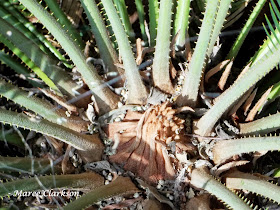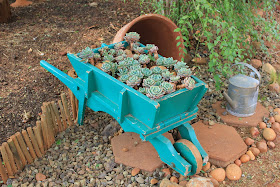"Winter ends,
and Spring comes,
and he who would have it otherwise
would have high tide always
and
a full moon every night."
September has brought many surprises - virtually no Spring to speak of, no usual early Spring rains and boiling hot weather. I've virtually had to have my sprinklers running every day, early morning, so as not to scorch the plants in the mid-day heat, with the ground being bone dry again the next morning.
The area where I live is blessed with good, deep top soil with no rocks or stones but contains no clay, with the result that water quickly disappears down to a level that the plants can't reach. That again has the advantage that our water table is quickly replenished and Tarlton is renowned for its strong boreholes. But it is still worrying having to pump water to fill the tanks everyday when I water the garden so much.
The borehole is the lifeline of a smallholding. The Spring rains are always eagerly awaited. Having a borehole dry up on you means great expense to either deepen the hole or drill a new one. It also means no water for the garden, no drinking water for the animals, no water to bath or wash dishes, flush toilets or even for washing hands. So roll on Spring rains, we eagerly await you!
Most of my Spring chores have been done - all dead growth has been removed now that the fear of any more cold or frost is gone and the whole garden has received a good sprinkling of compost. I've divided my geranium and managed to get three more plants to put in pots. One of them is even flowering already. When they are stronger, they will go into the chicken run where I'm slowly building up a little garden area for the chooks.

The Zebra Grass was cut down and received a good sprinkling of compost. Zebra grass (Miscanthus sinensis ‘Zebrinus’) also known as Chinese silver grass, Eulalia grass, maiden grass, zebra grass, Susuki grass, porcupine grass and which gets about 1.5m tall, has emerald-green foliage which develops golden stripes in mid-summer, and silvery plumes appear in autumn and last through the winter, after which the plant turns dry and yellow, needing to be cut down after winter. It is native to eastern Asia throughout most of China, Japan, Taiwan, and Korea and one of the few non-indigenous plants in my garden. It makes a great screening plant if planted close together (they spread quite profusely, I've already removed and transplanted clumps a couple of times) and it's also quite impenetrable. During summer my chooks love to hide under them from the hot sun.

Plumes of the Zebra grass



The Arums lasted well through the winter but unless they get enough water in this hot weather, they will soon be dying down.
Bulbinella
Bulbinella flower
The herb garden looks rather bare minus the Marigolds and Spring Onions, but hopefully these have seeded well and will be appearing soon.
My four Clivias are still going strong and are in full flower now.
Erigeron daisies - what a joy to have in the garden! Erigeron karvinskianus (Mexican daisy) has Grey-green foliage with masses of white to pink small daisy-like flowers most of the year. Evergreen, hardy, drought resistant, realiable. They self-seed and also have a spreading habit, making for a lovely ground-cover. They are also a lovely hanging basket specimen. This wildflower is orginally native to much of South America but has naturalised in Africa and has a maximum height of 15cm and prefer full sun.
Geranium flower
Monkey-tail cactus and my transplanted Geraniums on a pallet on the patio.
My Phormiums seemed to have doubled in size during winter. Phormiums are endemic to New Zealand and also known as New Zealdn flax. The tough, sword-shaped leaves grow up to three metres long and up to 125 mm wide. They are usually
darkish green but sometimes have coloured edges and central ribs. This Phormium tenax was one of the first plants I planted in my garden before deciding to go indigenous.


Never have my Black Karee's (Rhus lancea) been so full of seeds as this year. This is a small to medium-sized evergreen tree indigenous to South Africa with somewhat drooping branches. They grow to between 6m to 17m tall and mine are now about 7m. They are a wonderful tree to have in the garden as they attract fruit-eating
birds such as bulbuls, guinea fowl and francolins. Bees and other insects are
attracted by the flowers and baboons absolutely love these berries. At our previous smallholding we often had troops of baboons visiting in Spring to feast on these seeds, not to my delight at all. The dogs would go into a frenzy and we had to keep them locked up all the while the baboons were there - a large male baboon is NOT something you want your dog to tangle with!
The Sympervivums have weathered winter well and have made quite a few pups.
The Echeverias I transplanted from the garden into this old wooden wheelbarrow have taken nicely and are starting to look great once more.
My Cycad - Cycas Revoluta (Sago Palm) - is also looking great. It is a palm-like cycad in the family Cycadaceae, native to southern Japan.
I planted this one in 2007 and I am so blessed that it has just gone from strength to strength.
::



















































